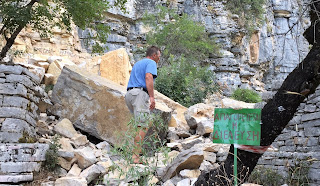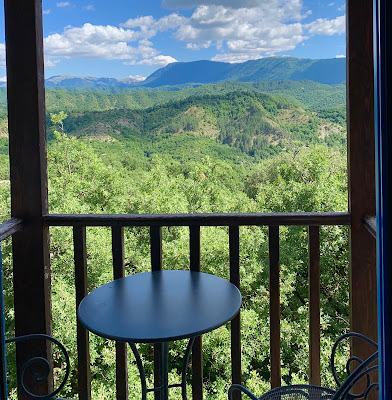Nature barely makes herself known with the bird songs so muted it’s as if they’re whispering. The distant rumbling of a car as it makes its way along the winding road alerts my ears. And yet at home, in New York, the hum of the highway--no not hum, because that conjures up a pleasant un-annoying rhythm. Rather, it’s the bang and rumble of voluminous lives passing at top-speed-- that is a constant jar to the senses. Yet, here a small intermittent motor sound as it passes between trees and makes its way up the mountain, jolts us from the quiet and I think of times long passed.
My first encounter with that particular road was in 1983, passing through Vitsa on the way to Monodentri. I was sitting on the back seat of a compact car. Nick, my new husband of one year, sat in front. Vangelis was the driver, a bit older than we, whom I saw as Nick's role model and father figure. To Nick he was just a good friend.
Fofo, Vangelis’s wife, was with me in the back. My only thought was that I might vomit at any moment and despite my inhibition-ladened self consciousness I was able to finally say, “Stop! I need to get out” because the alternative would have been messy and embarrassing.
This was, of course, before the Egnatia Highway was built so that this trip to the mountainous region of Zagori had been started hours before, in Margariti, and we’d endured a great number of winding serpentine roads over kilometers of mountains and through countless villages. My nausea had started somewhere within twenty minutes of the three hour drive.
I felt better immediately after I left Vangelis's car. My feet were pleased to be the transporters of my direction, but my stomach still churned. Nick walked with me and the car moved at walking speed beside us. Our destination was Monodentri. It was July 26, St. Pareskevi’s Day. The pilgrimage was one that volumes of people had undertaken. This I realized as the car pulled into a small, almost vertically inclined, parking area and Vangelis negotiated a place for his tiny vehicle, among others that were haphazardly strewn.

I mostly remember the crowds of people and the tiny church we crowded into and then our trek down a path to a landscape that would have been breathtaking had I not been overwhelmed with the shock of foreignness that suspended me in time from the moment I’d departed from the Olympic Airlines flight several weeks before.
Fast forward thirty years. Monondentri has all the charm of yesteryear plus the improvements of the modern word. Many bemoan this influx of modernity with its variety of tourist attractions, but not this author. Choice is good, no? It equates to a bit of freedom. There are many attractions like The Rizareio Exhibition Center's photography exhibits and the Theater of Agelos Kitsos. And, of course, the St. Paraskevi Church, built into the rock still stands.

 The path behind the little church that leads to the gorge has been crumbled by falling rock. At least it was at our last visit in 2019. Hadn't it been nature's territory all along? She simply took it back for a time, by throwing boulders on it and requiring those with the most motivation to slink along the deep edge to arrive at the gorge. The signs posting the imminent danger are mostly ignored. A quintessential Greek trait that absolutely endears them to me.
The path behind the little church that leads to the gorge has been crumbled by falling rock. At least it was at our last visit in 2019. Hadn't it been nature's territory all along? She simply took it back for a time, by throwing boulders on it and requiring those with the most motivation to slink along the deep edge to arrive at the gorge. The signs posting the imminent danger are mostly ignored. A quintessential Greek trait that absolutely endears them to me.
On the road out of Monodenri, once again we come to Vitsa, a village that holds a warmth and charm unlike any other. Simple and unassuming it's the perfect place for a few drinks and a snack or two before heading back to Margariti.
Here are the links for The Nifi, Your Own Kind, and Among the Zinnias. I hope you'll give one of them a try!




No comments:
Post a Comment